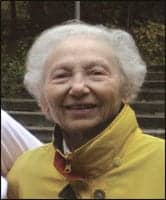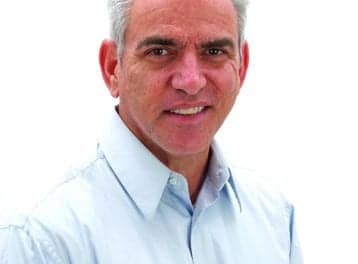
|
Some people are born to audiology, others have audiology thrust upon them…
Was she too embarrassed, or did she simply gamble that you’d find out for yourself? Here’s what your mother never told you about earmold acoustic formulae—a breathless tale of venting, acoustic resistance, and flared earmold tubing.
When I was quite young, as my mother (pictured) was putting me to sleep, like all mothers, she would tell me about all of the interesting statistical and physical formulae that she thought I would need to know in life. I recall my mother saying that, if there were statistically significant interaction effects, one could not trust the main effects in an ANOVA (and to always check for homogeneity of the variance). I lost plenty of sleep over that one. I also remember an interesting story about the specific impedance of a tube and how the world was saved by a judicious use of 1500 ohms of acoustic resistance. I am sure that your mother told you similar stories, which is why, of course, we all went into Audiology and hearing health care (or developed a sleeping disorder).
The following are some of the things that my mother told me about when it comes to earmold acoustics, as well as some things she didn’t let me know at such a tender age. Some are quite familiar, whereas others may be more obscure. Nevertheless, all can be used to help select the appropriate characteristics of earmold plumbing when we prescribe and fit hearing aids. This will be covered under the three main categories: venting, acoustic resistance, and flaring of the earmold tubing.

|
| Marshall Chasin, AuD, MSc, AuD(C), is the director of auditory research at the Musicians’ Clinics of Canada, Toronto, and an editorial advisor for HR. His latest book, Hearing Loss in Musicians: Prevention and Management, was published by Plural Publishing in March. |
Venting
Venting was one of the first stories I recall my mother telling me about. You have to realize that I was told these stories in the late 1950s when active feedback management control was decades off. My mother would always tell me that, clinically, I needed to provide my clients with the largest vent that I could get away with. Being only 4 years old at the time, I had yet to take my first course in acoustics and algebra, so I found what she had to say a bit hard to believe.
She said that vents reduce gain for the lower frequency sounds and have their greatest effect below 1000 Hz. She also told me that the mass of air that was trapped in the vent acted as acoustic inertance—and I must admit that I found comfort with this. The mass of air oscillates as a single unit and provides a resonance at about 400 Hz to 500 Hz, and this would slightly offset the effect of the vent by enhancing sounds in this region.
Being 4 years old, I had trouble recalling this information, so she gave me this important formula, which she had stolen from a young Australian schoolgirl named Robyn Cox:
F = 5500 Hz (πr2 / loVe)1/2
We are all quite familiar with this formula, and I recall playing with the square root calculations until my father came home from work the next day. This is simply 5500 Hz times the square root of the cross-sectional area of the vent in cm2 (πr2) divided by the length (lo) and the volume of air (Ve). I believe that the original formula didn’t have the subscripts, but my mother thought that she would put them in since it spelled something that a 4-year-old might like. If you ignore the 5500 Hz term (as most children do), the resonant frequency of the air trapped in the vent is simply proportional to the area and inversely proportional to the length. In other words, a long, narrow vent will have a relatively low frequency resonance, whereas a short, wide vent will have a higher resonant frequency. The way I remembered this was that Boris Karloff was tall, thin, and a bass, while Mickey Rooney was short, pudgy, and a tenor.
My mother would patiently explain that a hearing aid (or a hearing protector) with a long narrow vent would have a 300-400 Hz resonance that caused a person’s voice to be quite noticeable. I didn’t understand that she was talking about the occlusion effect, but then again, I was only 4 years old. She told me that short, wide vents were probably better at minimizing the occlusion effect since the resonant frequency would be higher.
I recall a rather stern warning one night that I was not to forget that the resonant frequency varies as the “square root” so that I must make both changes (in diameter and length) for any real change to occur. She explained that changes inside a square root sign would result in smaller changes than outside. I commented that this was also true of logarithms; I understood perfectly and went to sleep.
The physics of compression: eerie prescience or just an upset tummy? I was, however, woken up near midnight when I overheard an argument between my mother and father. When the shouting and crying had stopped, both of my parents came into my room and told me that they had something important to tell me: I was never to forget that the venting would also have an effect on the real compression ratio that I was to set. I found this odd because hearing aids of the 1950s were linear, but I always listened to my parents.
They explained that, with large vents, low frequency sound would enter the ear canal directly bypassing the hearing aid, which would add up with the low intensity and low frequency output of the hearing aid, thereby altering the slope of the input-output [i/o] function of the hearing aid for low intensity inputs.
Acoustic Resistance
Whereas venting was mostly for altering the low frequency sound transmission, my mother was excited to introduce me to acoustic resistance, which had a mid- and high-frequency effect. She explained that what was so exciting in the study of acoustic resistance was that its effect would depend on where the resistance was placed in the hearing aid tubing and ear hook system. This gave my mother the perfect opportunity to explain standing waves to me—certainly an exciting period in my childhood!
She told me that an acoustic wave propagating in any tube depends on the boundary conditions, but it was primarily governed by the length of the tubing (and not the cross-sectional area). I found this hard to believe initially and this caused much family strife for years to come. However, like most things, we later come to realize your mother is always right. What made my childhood so easy was that my mother thought that it would be best if we dealt only with the “closed on one end” and “open on the other end” boundary condition. This introduced me to the wonderful world of quarter wavelength resonators, and the formula that she whispered to me as I fell into a deep and restful sleep was:
F = (2k-1) v/4L
I was initially cautioned by my father to ignore the (2k-1) term, and he was quite correct …
Well, technically he was wrong but his caution was well meant. My father was always well-meaning. I concentrated on the v/4L factor and realized that hearing aid tubing resonances were governed by the speed of sound, or v (which really can’t be altered too much), divided by 4 times the length (L) of the tube.
Being 4 years old, I knew my 4 times tables well and was quite capable of calculating the first resonance of a 75-mm-long acoustic system that was “closed” at the receiver and “open” at the end of the earmold bore. I assumed for ease of calculation (since I was doing this in my head while snuggling with my teddy bear) that the speed of sound was 340 m/sec (or 340,000 mm/s in Canadian) and therefore the first resonance in a 75-mm-long tube would be about 340,000 mm/sec / 300 mm = 1100 Hz. I was later to learn in life (by my fifth birthday) that this was called the “1000 Hz” resonance and was characteristic of all like tubes of this length. I just assumed that my calculations were off (since calculators were not yet available, and I was not allowed to play with pencils in bed for fear that I would poke my eye out when trying to sleep). My mother explained that people sometimes just approximate things and that my calculations were quite adequate for a 4-year-old.
For my fifth birthday, my father allowed me to add the (2k-1) term back into the equation and, to my great surprise (and great enjoyment), I realized that this 1000 Hz resonance had “friends” at odd numbered multiples of 3000 Hz and 5000 Hz. The 5000 Hz resonance that I calculated in the late 1950s was purely academic because my mother told me that modern 1950 hearing aids really only went up to 4000 Hz at most so I didn’t need to worry my little head about this supersonic 5000 Hz resonance.
Just when I thought that I had learned it all, my mother introduced me to the specific impedance of a tube. I still recall, about 50 years later, she told me one morning (over a cup of hot chocolate) that the specific impedance of a tube was given by the following formula:
Specific impedance = 41 ohms/cross-sectional area (in cm2)
She did caution me about those who erroneously called this the characteristic impedance, and I was not allowed to play with these children.
When I sat down to do my calculations after nap time, I found that this works out to be about 1300 ohms for #13 tubing, but can be as high as 5200 ohms for a 1 mm inner diameter thin tube. My mother explained that this would be the maximum amount of resistance that could be placed in the tubing to obliterate the tubing-related resonance. She explained that, if a 1300-1500 ohm resistor was placed in the hearing aid tubing or the ear hook nub, there would be a smoother etymotic response.
I didn’t know what “etymotic” meant then since I had yet to start my ancient Greek lessons, but my mother told me that it was sometimes OK not to understand everything. That same night she told me that acoustic resistance was probably not needed with thin tubes since many were used in non-occluding hearing aid fittings. This was a time of great joy and excitement since I got to use the vent formula that my mother had told me about once again. I had never considered a non-occluding fitting as a maximal condition for a vent. This left me almost breathless; I barely slept that night!
Flaring of the Earmold Tubing
One fall evening, both of my parents came into my room and quite somberly explained to me in hushed voices that, if you consider all those frequencies in which one-half of their wavelength is less than the length of the tube, then those are enhanced by having a larger cross-sectional area. They both glanced at each other, then to me, and said that this was the acoustic transformer effect. They felt that I was old enough for this, now that I had just celebrated my fifth birthday.
Well, obviously I was shocked. I had grown up thinking that length (L) was the primary element in acoustics. There were some rumblings that cross-sectional area was important, such as with the specific impedance, but I thought that that was an aberration. After some tears, we settled down to do some calculations. My mother, wiping away tears from my eyes, explained that—when a tube is gradually flared and the flare is at least one-third the total length of the tubing—then this serves to enhance the intensity of the higher frequency components.
They both gave me this important formula to help me remember the acoustic transformer effect, so that I could one day pass it on to my children:
F = v/2L
I looked at them strangely because this looked very familiar—it was a one-half wavelength resonator model! I was told to calm down, and that this was merely a coincidence. (At this point I suspected for the first time in my life that my parents were lying to me.)
My mother said that this formula would help me find the frequency that a flared tube would start to have its effect. Placing L = 75 mm for a behind-the-ear (BTE) hearing aid in the equation, I calculated that F = 2200 Hz. My mother explained that a flared tube that gradually increases its inner diameter would have increased intensity for all frequencies above 2200 Hz.
Suddenly, a stern look came across her face and she commanded me to do the calculation for a 60-mm-long tube—such as those found with smaller headed people such as infants. My mother is so clever. The calculation now comes out as F = 2800 Hz. That is, an infant would not derive as much benefit from a flared tube as would an adult, and the effect would not occur until 2800 Hz and higher. I thought that this was unfair and up to this point had considered acoustics to be devoid of ageism.
Acoustics seemed to prefer adults. This was a rude awakening.
My mother only let me stew in self-pity for about a minute until she asked if I would like to know how much the flare’s effect was? I jumped at the chance. Mom explained that this was called the amplification factor, given by another exciting formula:
Amplification factor (dB) = 20log (diameter #2/diameter #1).
This was exciting since I got to use the log tables that I had just received for my fifth birthday. My mother asked me to calculate the amplification factor for flaring a 2 mm inner diameter #13 hearing aid tubing to a 4 mm one, as suggested by Uncle Cy. I got to work and calculated all morning. After several hours, I found that I got a value of:
20log(4/2) = 20log2 = 20log2 = 6 dB.
My mother said that I was correct and that 6 dB was the highest amount of high frequency amplification that could be obtained. I stupidly asked her why I couldn’t just turn up the electrical gain by 6 dB in the higher frequencies. Mom said that I could, but that would decrease battery life; additionally, when done acoustically, it maintains the relationship between the gain and the OSPL90, whereas you might run out of headroom if you do it electrically. (Despite this being the late 1950s, my mother was ahead of her time!) She always told me that an acoustical modification was generally better than an electrical one.
I exclaimed, “Mom, let’s do this for a thin tube that has an inner diameter of 1 mm and see what happens when it ‘flares’ to 2 mm, like #13 tubing!” We spent a glorious morning doing the calculations, and to my surprise, the amplification factor was still 20log2 = 6 dB. So it seems that, if the inner diameter is doubled, a 6 dB increase in the higher frequencies is obtained regardless of the initial tube used!
My head was spinning at this but I felt happy. It was time for bed, and I kissed my mother and father goodnight.
Citation for this article:
Chasin M. What your mother never told you about earmold acoustic formulae. Hearing Review. 2009;16(12):10-14.





